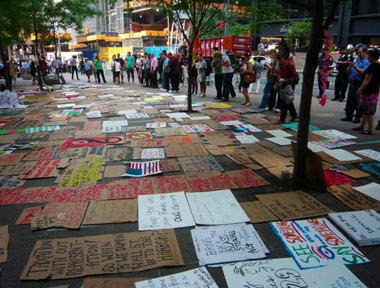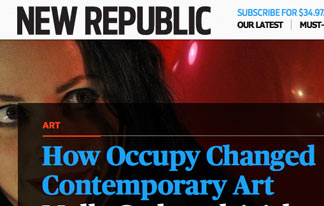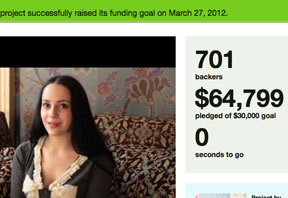Did Occupy Really Change Contemporary Art?
I almost spilled coffee on myself yesterday when I read this bombastic headline in the New Republic: “How Occupy Changed Contemporary Art.” Then I laughed out loud.
It’s just that I die inside a little bit more each time when I read yet another “art review” written by someone purporting to be an authority on the subject. While I understand the impulse to write sensational headlines to promote someone, it’s just too much to take when that gets mixed together with the Occupy Wall Street rhetoric.
Somehow the article, which was supposed to be a review about New York illustrator Molly Crabapple, morphed into an attempt to elevate her as an example of a new “vanguard” of Occupy artists who favor vague things like democracy, fairness, and sharing. The reviewer goes on to claim that her using Etsy and Kickstarter is proof she is the real deal.
Sure, I can understand the author’s enthusiasm for Crabapple, an attractive former nude model and illustrator, but it’s hardly necessary to oversell her by claiming she is an avant-garde artist. By doing so the author inadvertently seeks false validation, implying it’s not OK for a woman to work as a nude model and that an attractive woman can’t get respect unless such lavish claims are made on her behalf.
Besides, according to Fastcompany, she hardly needs such blustery advocacy, noting that “at 29, Crabapple is making six figures a year — and she has for the past three years.”
Not to mention the fact she already raised almost $65,000 through Kickstarter for the show being reviewed, and it all went to her, because it’s her project — not to “the cause,” whatever that is. Yet the conflation of her and Occupy implies that by supporting Crabapple, you are supporting Occupy.
But sadly, it looks like yet another blatant marketing scheme capitalizing on the brand built by anticapitalists. How’s that for irony?
Of course she perpetuates all this artspeak nonsense on her Kickstarter page: “Your support in this project will help me cover the cost of creating spectacular art that’s meant for everyone to enjoy. And help me do it without asking the permission of rich people. Because art is awesome. And big, splashy, gold-encrusted, glittering things are awesome. But so is populism. I want to see how they look together. ….While I’m making Shell Game, I want you with me.”
Shell Game? Is this a con? Forgive me if I am not impressed. Since when did rich people need to give anyone permission to make art? She’s raised $65,000, AND she’s selling these paintings for thousands of dollars each. No joke. This is a SHELL GAME!
And then there’s this praise-filled article (complete with photo spread) from a style blog about her that deserves to be quoted at length:
“… Molly lives a post-impressionist fantasy as a successful artist herself in a loft in NYC, that is replete with chandeliers, paper lanterns, burlesque postures, plumes, and art everywhere. When Molly is home painting and sketching her ‘hyper-detailed surrealist Victorian pictures,’ she is in an embroidered silk robe, gold and pearl Rococo slippers, and might be obsessing over a pair of Alexander McQueen Gilly booties etched with almost medieval knot-work. But when out and about, like a 19th-century painting, Molly is in hourglass silhouettes, crinolines, crocheted gloves, veiled head pieces and other arcane accessories.”

Before Zuccotti Park was raided and Occupy Wall Street was pushed out of Lower Manhattan, hundreds of posters and signs were made by anonymous artists, few of whom ever got any kind of compensation for their time or artwork.
While I would never begrudge another artist making a living or having success, the New Republic article never thought to question the obvious contradictory elements of this whole marketing strategy. While she is getting her moment in the sun (see the Rolling Stone article + flattering photo here), the truth is that she lives in Lower Manhattan and her career was well under way long before the Occupy movement began. Fastcompany also quotes her saying, “What you get in this world doesn’t come from how much you ‘cultivate your talent’ but how much you ‘cultivate your name.'”
So come on, New Republic, be honest, is she really an example of someone who has “changed contemporary art” by fighting for “the cause”? I just don’t see it. If anything, the artist is just reinforcing the idea that financial success = artistic success.
In reality I’d say 99% of the “art” that came out of Occupy is agitprop. There’s nothing wrong with that, but why not call it what it is?


Comments (10)
-
Chris Cobb says:
May 6, 2013 at 8:12 pm
-
Sam says:
May 6, 2013 at 4:52 pm
-
Rachel Haywire says:
May 3, 2013 at 2:43 am
-
Chris Cobb says:
May 2, 2013 at 9:30 pm
-
Chris Cobb says:
May 2, 2013 at 9:12 pm
-
Tim says:
May 2, 2013 at 4:00 pm
-
Stacey says:
May 2, 2013 at 3:47 pm
-
Adam says:
May 2, 2013 at 3:11 pm
-
Sxip Shirey says:
May 2, 2013 at 3:04 pm
-
Mac McGinnes says:
May 2, 2013 at 9:19 am
See all responses (10)Sam – to your first point – You’re being generous. Although the writer may not have written the headline, the Editor is ultimately responsible for things like fact-checking, headlines, proofreading, etc. As a result, whatever appears on that site becomes a “New Republic” piece.
To your second point – the only people getting rich off peer to peer sites like kickstarter, etc. are the sites themselves, as they get a cut of anything you raise. The harder you work, the more they get. They have no way of justifying their percentage cut, since all they do is maintain the infrastructure and leave you with all of the tax problems, all the work of collecting the funds from all the donors, etc.
Furthermore, on the kickstarter website they claim their customers have raised over 500 million dollars since 2009, with them getting a 5% cut. Not too shabby for just setting up a website for people to use – 5% of 500 million is 25 million dollars!
1) I’m just guessing that the writer of the article didn’t write the headlines. Editors often write these kind of headlines to get attention – you’re right to call it bombastic and hyperbolic.
2) If she is doing anything different or new, it seems less about the narrowly-framed question of whether artists are using Kickstarter or not, and more, according to the writer, about how she and other artists are operating “outside the big-collector system” and “building followings and funding” her own work. Moreover, not only is she operating outside that system but more and more artists aren’t even interested in working within that system, according to one of the quotes. I don’t know if that is true or not, and I’d be interested in hearing what people think about that assertion or if we have any data to support this idea. My own hunch is that yes, an increasing number but still not very significant number of artists are growing disinterested in working within the system of galleries and collectors (which is an obvious effect of the internet, the scarcity of opportunity within the gallery system, and, finally, the growth of a sharing economy that values peer-to-peer exchange). The “irony” that the articles points out is that even though these artists are less concerned with the “buying public” – revolting phrase when applied to art – the work is inevitably recovered by the very collectors and galleries that they are supposedly indifferent to.
3) The idea of artists who are not interested in working within the galleries and collector-system doesn’t seem very new to me, but it does seem at least vaguely related to the themes of the occupy movement, insofar as that movement’s rhetoric contrasts the 1 percent with the 99 percent. Again, it’s more of just a loose affinity of ideas and not a direct relationship. But that sor tof thing happens a lot throughout art history, doesn’t it?
4) I guess I’m left with the question about why this matter, whether of not anything really novel is going on here, and what the true significance is. If there really was a widespread peer-to-peer movement in the arts, what would that look like? How would it effect artists and their ability to make reputations, livings, and to develop their work within a critical viewing public? So in sum I think the article raised some interesting points but generally didn’t deliver much in the way of answers.
Finally!
The emperor is naked.
Thank you for pointing out what a lot of us have noticed for years. How can some millionaire business expert claim to represent the people? She represents a study in political marketing fads. Her “art” is pandering trash.
@Sxip Shirey – you say: “…she absolutely is changing contemporary art.”
I would challenge you or anyone to tell me how. The author of the New Republic piece did not explain it, and I am guessing you can’t either. Here’s why – a million artists are using kickstarter, etsy and indiegogo to raise money for their work and their projects. If that is your criteria for changing contemporary art, then you would have to say a million people are all changing it, which means she is hardly the “vanguard” that piece suggests. In fact, it seems like she is a little late to it.
You also say: “… they are starting to take manners into their own hands and guess what, it’s working.”
While I understand your point, I don’t I agree with you. The entire history of art is about artists “taking matters into their own hands.” They do so because the world can be cold and cruel and indifferent towards artists and their needs. Yet a lot of artists use kickstarter and indiegogo and don’t make any money or their projects don’t get funded. Are they changing the system too or are only the financially successful ones changing the system? I think that’s a valid question to ask.
Hi Tim and Adam, if you take the time to read the New Republic review, which is what my post is actually about, you will see the writer mentions her work as a nude model, etc. It is relevant because she built an audience based on her involvement in the “Burlesque world” where art, illustration and uh, burlesque all sort of mix together. That audience, I am guessing helped push her over her goal by $34,000!
Also – Tim, I am addressing her at length because she is the subject of that hyperbolic review and simply pointing out she is a bad representation of whatever an “Occupy artist” is, since the claims in that review are more than over the top. Moreover, I am not really addressing her work since this is not an art review. This is a post about a review that was so flattering of her it was embarrassing for the New Republic.
Wait, wait, I don’t understand this review. Cobb, can you please tell me specifically why you mention her qualifications as a nude model or as an illustrator? What purpose does that serve, other than for you to snigger in print about something apparently you find somehow reduces her value as an artist?
And explain one more thing: where, in this blor purportedly about art, do you actually discuss her art?
I really don’t think very much of the job you’ve done here. Are you proud of this?
I love art & more specifically, the art of Ms Molly Crabapple / but I did find it amusing that someone who is clearly from privilege and lives as such (her flat is a beautifully appointed palace in the heart of the financial center of the US) could really make art that reflects the hearts & minds of the people fighting for the rights of every-day workers. She should make richly expensive art in her tower over Wall Street, but don’t expect to be one of us just because you say you are…
Now, I’m just a layman here, but I don’t get what Crabapple’s appearance or previous employment has to do with her art. Can you explain why that’s more important than her art? This is a blog about art, right?
Or is this dumb Texan just missing somethin’?
Molly is an active part of NYC. As an artist, as an activist as a social person. I find her art energizing, populist and smart. Her methods for making a living are honorable and it’s funny to watch the old art establishment judge her on her methods when the whole art school/gallery/museum system is bloated with nepotism. She has and audience and she services that audience. She works her ass off and she absolutely is changing contemporary art. You have a job don’t you? You have health insurance? You have some sort of financial security? Well most artists don’t, and if they wait for the system that you represent to reward them it’s not going to happen. So they are starting to take manners into their own hands and guess what, it’s working.
Bravo, Mr. Cobb!
Mac